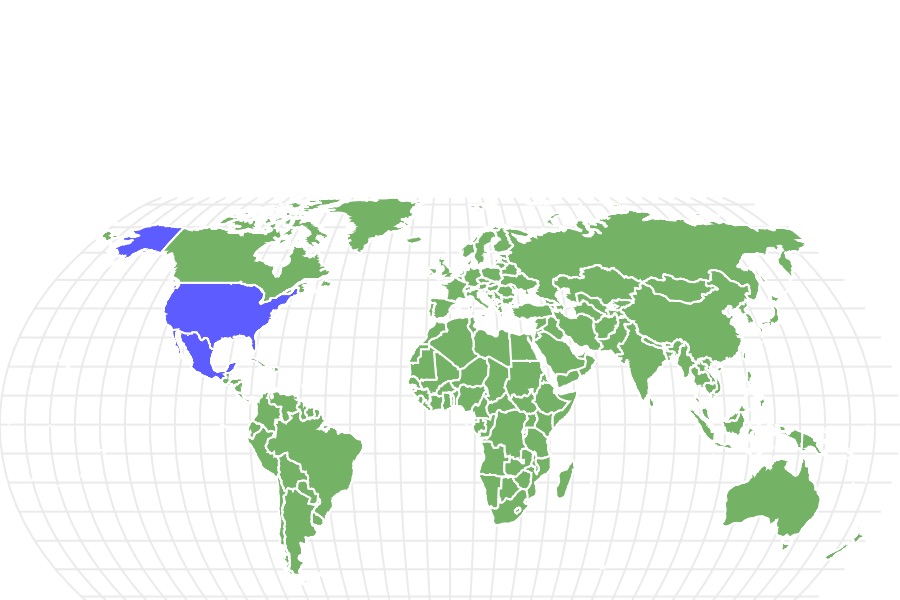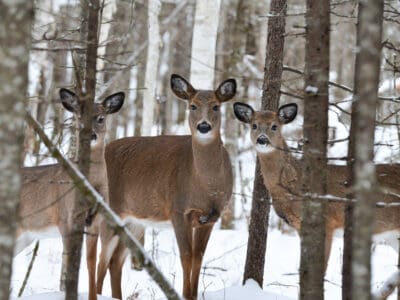Gopher Snake
Pituophis catenifer
Gopher snakes can reach up to 9 feet long.
Advertisement
Gopher Snake Facts
Gopher Snake Physical Characteristics
- Color
- Yellow
- Red
- Tan
- Dark Brown
- Cream
- Lifespan
- 15 years in wild, 33 years in captivity.
- Length
- 4-9 feet
- Venomous
- No
- Aggression
- Low
View all of the Gopher Snake images!
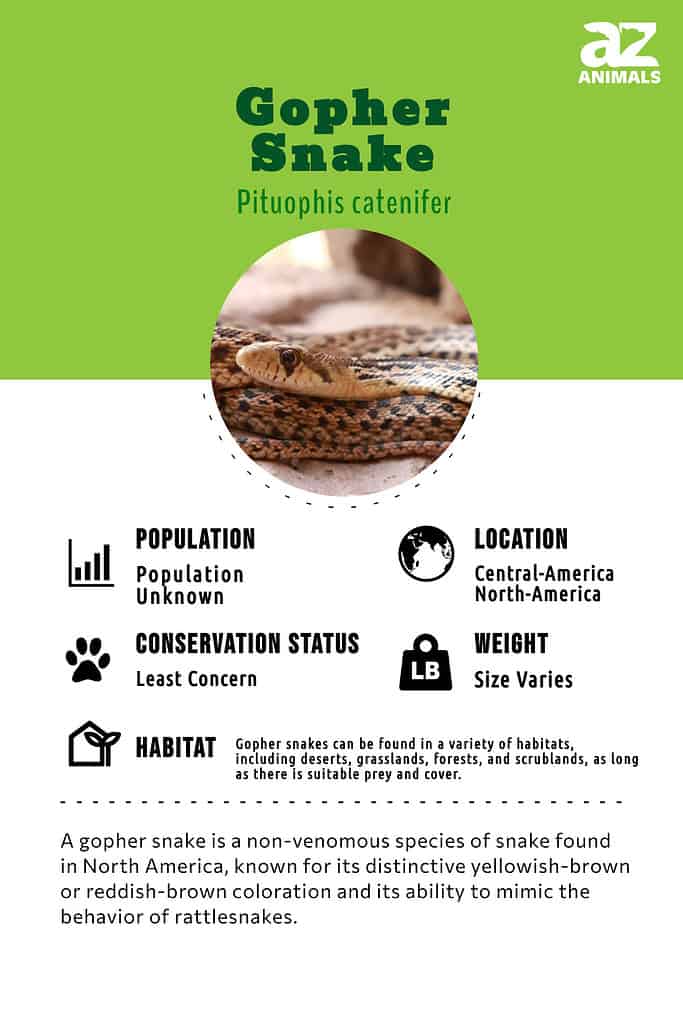
Gopher Snake Summary
“Gopher snakes can reach up to 9 feet long.“
The gopher snake, which includes 6 subspecies, is found primarily in the western United States, southern Canada, and northern Mexico. It thrives in arid climates below 2,000 feet altitude, and it is carnivorous. Though it has no venom, it has a painful bite that it uses to capture small prey (like birds and gophers). This snake is primarily docile, reaching up to 9 feet in length.
Gopher Snake Amazing facts
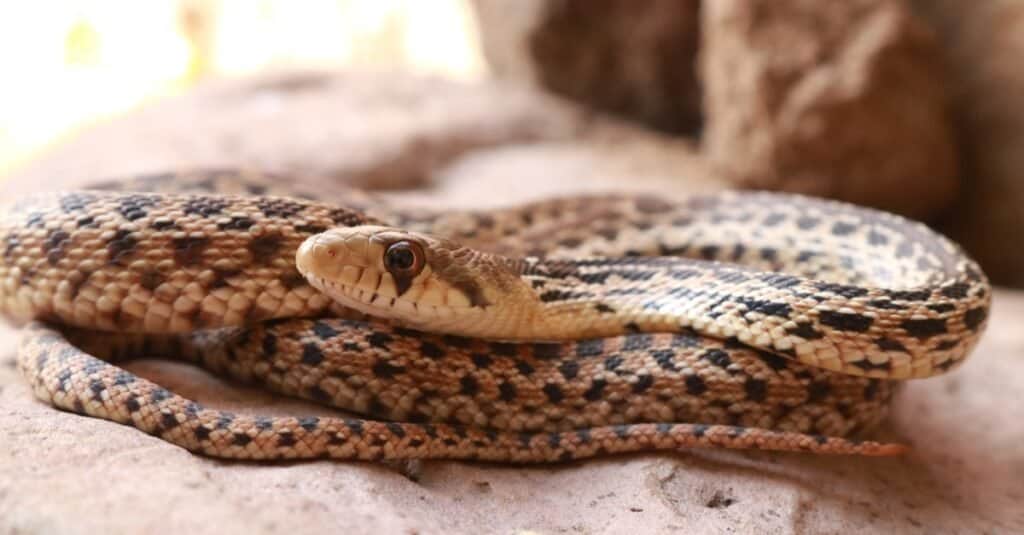
The gopher snake is commonly misidentified as a Rattlesnake because of its markings and defensive behavior. It may hiss loudly, flatten its head, vibrate the tail, and strike when annoyed.
©Creeping Things/Shutterstock.com
- Even though the bite of a gopher snake can hurt a lot, they don’t produce venom.
- They tend to be more abundant in arid climates below 2,000 feet altitude, like California, Utah, Wisconsin, and Texas.
- This snake is named for one of the main parts of its diet – the pocket gopher. Their diet also consists of other small mammals, birds, eggs, small lizards, and sometimes insects.
- There are seven subspecies of gopher snakes, which include the Sonoran gopher snake, the Pacific gopher snake, and bullsnakes.
Evolution and Origins
The gopher snake is a nonvenomous species that belongs to the genus Pituophis, which is part of the larger Colubridae family. The exact origins of the gopher snake are unclear, but it is believed that these snakes evolved in North America during the Miocene epoch, which occurred approximately 23 to 5.3 million years ago.
Gopher snakes are known for their adaptability to different environments and can be found in a variety of habitats, including deserts, grasslands, and forests.
They are also found in different regions of North America, from Canada to Mexico. Over time, different subspecies of gopher snakes have developed unique physical and behavioral adaptations that help them survive in their specific environments.
Despite their name, gopher snakes do not exclusively prey on gophers but are known for eating a variety of small mammals, birds, and reptiles.
Different Types
Here are the seven different species of gopher snake:
- Bullsnake
- Sonoran gopher snake
- Great Basin gopher snake
- Pacific gopher snake
- San Diego gopher snake
- Santa Cruz gopher snake
- Arizona black rattlesnake: (The Arizona black rattlesnake (Crotalus cerberus) is not considered a true gopher snake species, although it is sometimes referred to as the “Arizona black gopher snake” due to its similar appearance and behavior. It is actually a species of venomous rattlesnake, and is part of the larger Viperidae family.)
Note that some sources consider the Arizona black rattlesnake to be a subspecies of the western rattlesnake rather than a separate gopher snake species.
Where To Find Them

A gopher snake is coiled up and ready to strike.
©rawaccess/Shutterstock.com
The Pacific gopher snake, as the name implies, primarily lives along the West Coast along the Pacific Ocean for its main habitat. The range of this snake goes no further than California (since they don’t go in the water), but they can be found as far north as British Columbia and as far south as Mexico. They can be found in Utah, Wisconsin, Illinois, Missouri, and Texas.
They don’t like altitudes of more than 2,000 feet, staying close to the ground. Semi-arid and brushy areas are their preferred habitat of choice, which is why they are often found near farms. They also like pine forests, prairies, and dunes.
They hibernate during the winter, willingly congregating with rattlesnakes, whipsnakes, and other breeds in a den. In Utah, these snakes will even boldly make a place for themselves in parks, which may intimidate individuals who aren’t familiar with their harmless nature.
When the breeding season starts in June, male gopher snakes will no longer share these dens, becoming incredibly territorial over their habitat. However, as females start to lay their eggs in June and July, they’ll willingly congregate with other species again.
Scientific Name
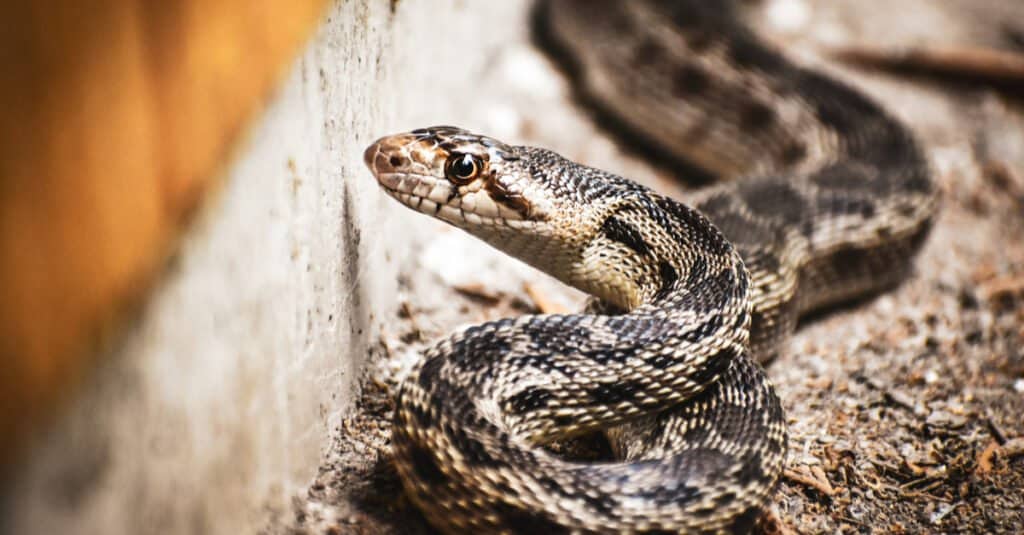
Gopher snakes can measure between three and eight feet.
©Cedar Dobson/Shutterstock.com
The gopher snake, which is also known as the Pacific gopher snake, California gopher snake, or Sonoran gopher snake, has the scientific name Pituophis catenifer. The name “Pituophis” comes from two Greek words – “pitys” (or “pine”) and “ophis” (or “snake”). “Catenifer,” however, is Latin, and it means “chain-bearing,” which is a description of the pattern seen on the back of the gopher snake.
It belongs to the Reptilia class and the Colubridae family.
Population and Conservation Status
The total population of the gopher snake varies among the six subspecies, which are divided by the region they natively live in. The Coronado Island gopher snake, for example, primarily lives in Colorado and California, while the Sonoran gopher snake is found in Arizona, Mexico, and California.
Among all of these subspecies, there is no estimated population, but the IUCN considers them to be of “Least Concern.”
How To Identify: Appearance and Description
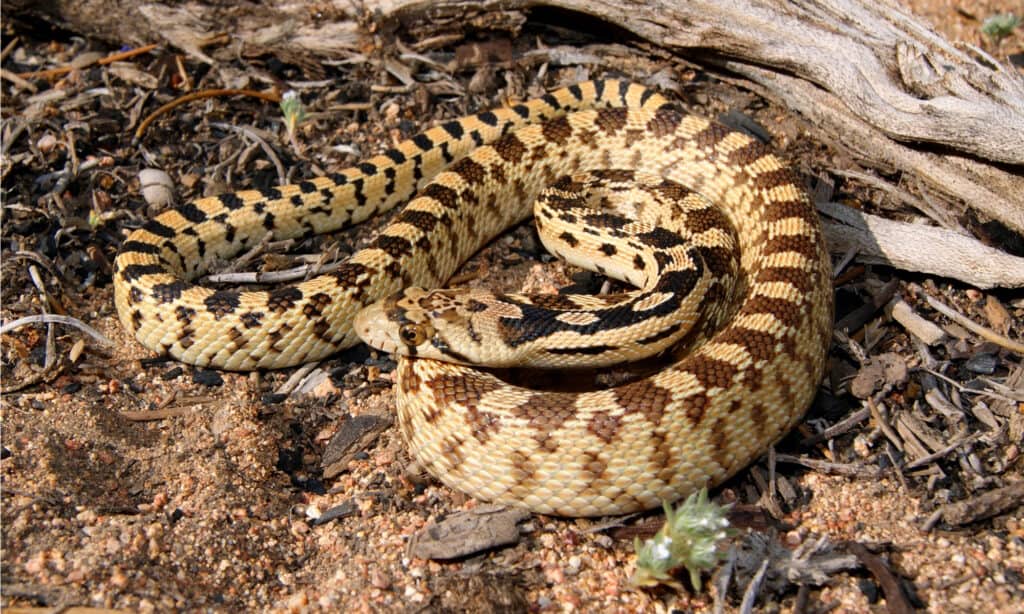
Great Basin Gopher Snake, Pituophis catenifer deserticola
©Matt Jeppson/Shutterstock.com
Their average length is 4 feet, though the right environment and nutrition make it possible for them to grow to a size of 9 feet. Their entire back is decorated with saddle spots that are either reddish-brown or dark brown down their entire back as the basic morphs of this snake.
They also have 2-3 rows of spots along both sides, though the spots on the second row tend to be a little larger. In total, the spots come up to 33-66 spots in total. Snakes in California have striped morphs that replicate these colors. In these
morphs, the ventral side is usually yellow with dark spots, becoming redder on the dorsal side.
How to identify a Gopher Snake:
- Tan, cream, or yellow ground color.
- 33-66 reddish-brown or dark brown blotches along the back, broken into 2-3 rows on each side.
- The second row of spots is larger on the side.
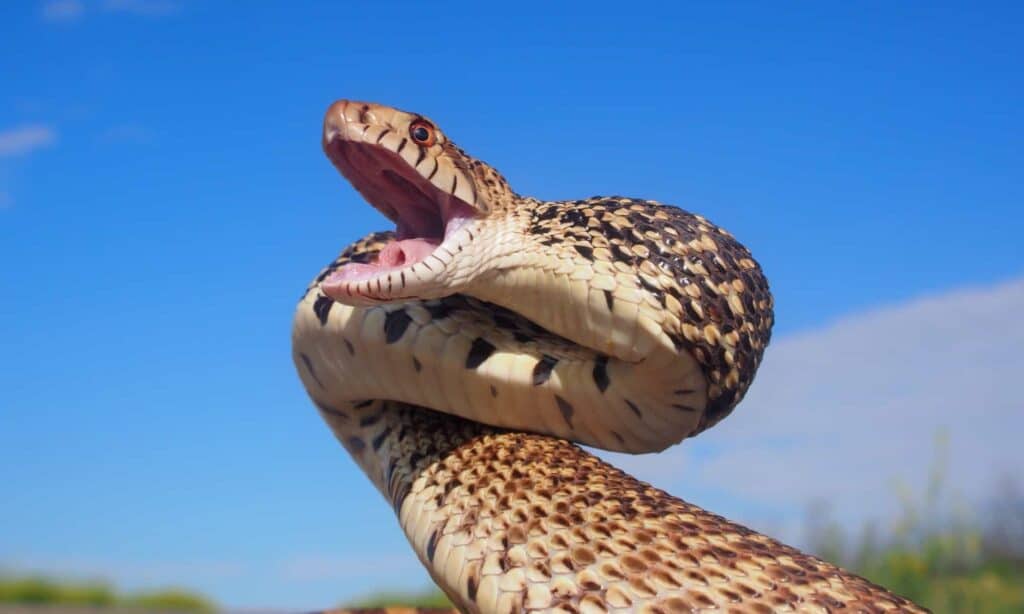
Gopher snakes, like this bull snake, make a great show of being dangerous — but they’re not.
©Markparker1983/Shutterstock.com
How Dangerous Are They?
The gopher snake is quite misleading in its behavior. When it becomes afraid or agitated by humans, it will make itself look bigger and flatten its head. It even makes a rattling noise with its shaking tail, which is only heard in dry areas.
Though it may look like it is about to cause as much harm as a rattlesnake, it can’t – this species is non-venomous and not poisonous. In fact, they are typically docile, and they pose no threat to humans (though the same can’t be said for the small mammals they hunt).
If a gopher snake bites you, seek medical attention to ensure the damage is no more than skin deep. The pain you experience with this type of bite is intense, so it is easy to mistake the animal for something more harmful, and it is always better to be safe than sorry.
Behavior and Humans
Overall, the gopher snake isn’t a threat to humans, and they are quite unbothered by them. They don’t go after a game that is bigger than a small mammal, so most humans aren’t even worried about seeing them in their yards. They aren’t dangerous or aggressive, and they mostly leave humans alone unless they feel threatened.
View all 170 animals that start with GGopher Snake FAQs (Frequently Asked Questions)
Can a gopher snake hurt you?
Yes. Even though they do not have fangs or poison, their bite can be incredibly painful as they clamp down hard on the skin. Proper wound care is a necessity after a bite, which is best done with a medical professional.
Are gopher snakes friendly?
For the most part, gopher snakes stay away from humans. They aren’t harmful, but they should be left alone in their natural environment.
Is a gopher snake venomous?
No. The gopher snake is not venomous or poisonous, and it is mostly harmless.
What happens if a gopher snake bites you?
Gopher snake bites pack a lot of punch, but they won’t cause any long-term damage. The worst reaction will be pain over the bite, but there is no venom. It is not poisonous.
How big do gopher snakes get?
Though the most common size of the gopher snake is about 4 feet. However, their size can reach up to 9 feet long in some environments.
What does a gopher snake look like?
The gopher snake is typically about 4 feet long, and it is covered with 33-66 brown or reddish blotches along its back. It has a light-colored belly, which is typically yellow, straw, tan, or cream.
Thank you for reading! Have some feedback for us? Contact the AZ Animals editorial team.

